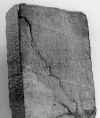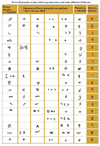The runic scholars who originally examined the Kensington Rune Stone (KRS) were convinced of the stone's in-authenticity primarily because of one letter found in the inscription.
In 1951, Erik Moltke, the official Runologist of the Danish National Museum, cited this "invented" letter as the conclusive proof of the The Kensington Runestone's in-authenticity:
|
|
"The fact is that the letter
'j' is a development within the Latin alphabet (like v). Both these
letters were invented by the French philosopher Petrus Ramus in
the 16th century." (Antiquity, 1951, p. 91)
|
However, in 1987, Richard Nielsen, writing in vol. 16 of Epigraphic Society Occasional Papers, pointed out no less than 8 uses of this admittedly rare symbol in the Codex Runicus.
It was therefore, unbeknownst to Moltke, an authentic 14th century nordic rune, and not a newly invented J-rune at all.
What intrests our research team the most, is that half way down, nearly
in the center of the inscription, one can clearly see a "glyph"
![]() complete
with "dot".
complete
with "dot".
Critics would argue that the ![]() symbol could have been copied from any of a hundren different places by
anyone with access to ancient old-world texts... but then the argument
comes full circle...
symbol could have been copied from any of a hundren different places by
anyone with access to ancient old-world texts... but then the argument
comes full circle...
What is an old-world rune doing carved 128 times on mesas around the american southwest?

| TEAM MEMBERS | WORKS CITED
CONTACT US @ WATER GLYPHS


